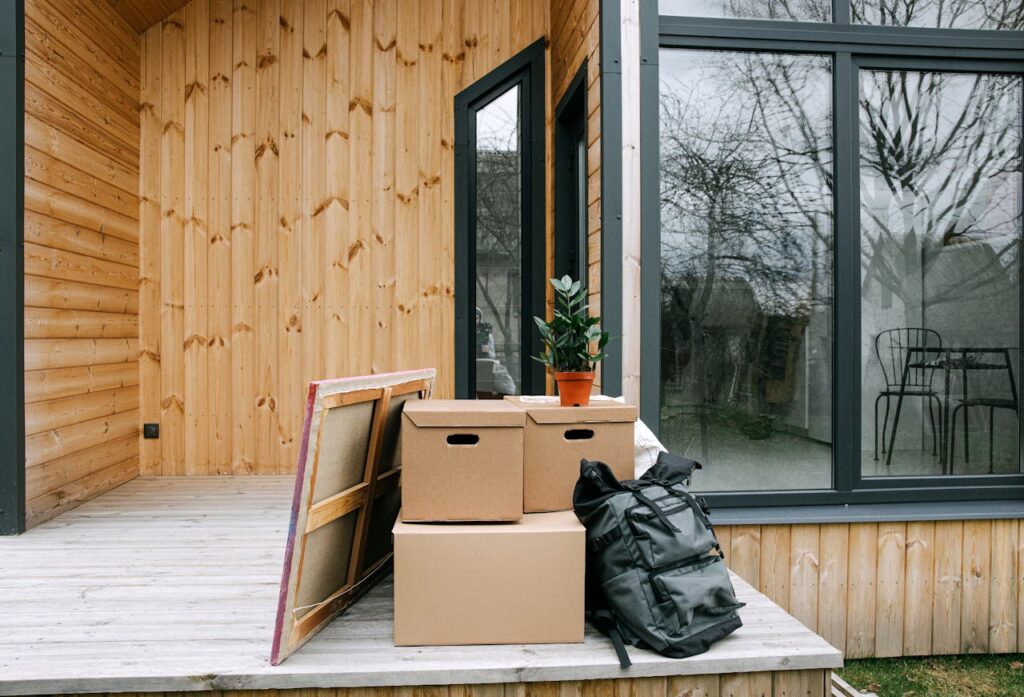How to Make Moving Day Hassle-Free with Proper Planning
Moving to a new home is often an exciting yet stressful experience. The anticipation of a fresh start is accompanied by the challenge of organizing, packing, and transporting belongings. Without a solid plan, moving day can quickly become overwhelming.
However, with the right approach, you can streamline the process and eliminate unnecessary stress. Proper planning ensures efficiency, minimizes last-minute hiccups and allows for a smoother transition.
Whether you’re relocating within McLean, Virginia, or moving from another area, following a strategic plan can make moving day hassle-free and stress-free.
Hiring Professional Movers for a Smooth Transition
One of the most effective ways to reduce the stress of moving is by hiring professional movers. Many people attempt to handle the process independently, only to find themselves exhausted, overwhelmed, and behind schedule. Professional movers bring experience, efficiency, and the necessary equipment to transport belongings safely.

When selecting a moving company, it is essential to research your options carefully. Look for companies with a strong reputation, positive customer reviews, and transparent pricing. Some movers offer full-service options, including packing, loading, transportation, and unpacking, while others provide only transportation.
A key advantage of hiring professionals is their ability to handle bulky and fragile items with care. Moving heavy furniture or delicate valuables requires expertise to avoid damage. Professionals use protective materials such as blankets, bubble wrap, and secure straps to ensure items remain intact during transport.
If you are relocating long distances, hiring a reputable moving company becomes even more crucial. Reliable movers ensure timely delivery, proper packing, and efficient handling of your belongings, making the transition significantly easier. By choosing the top McLean VA movers, you can experience a seamless and stress-free moving day, allowing you to focus on settling into your new home.
Creating a Detailed Moving Checklist
A well-structured checklist can be a game-changer when preparing for a move. With numerous tasks to complete, having a clear plan helps prevent oversights and keeps everything on track. Your checklist should include tasks such as decluttering, gathering packing supplies, notifying utility providers, and scheduling transportation.
Begin by setting a moving date and working backward to allocate time for each task. Organizing belongings systematically ensures that you do not pack unnecessary items, reducing the overall workload. Creating separate categories for essential items, donations, and discards can simplify the packing process.
Updating your address with relevant institutions should also be on your checklist. Notify banks, insurance providers, subscription services, and government agencies well in advance to prevent service disruptions. If you have children, informing their schools about the move ensures a smooth academic transition.
Decluttering Before Packing
Packing unnecessary items adds to the workload and increases moving costs. Decluttering before a move helps reduce the number of items that need to be packed and transported. It is an opportunity to get rid of items that are no longer needed or used.
Sort through each room and decide what to keep, donate, sell, or discard. Items in good condition can be donated to charities, while valuable but unused belongings can be sold online or at a garage sale. Disposing of broken or obsolete items before packing minimizes clutter in your new home.
Decluttering also makes unpacking more manageable. A home free of unnecessary items creates a more organized and efficient space, making it easier to settle in. Taking the time to declutter can make a significant difference in simplifying the moving process.
Packing Efficiently and Labeling Boxes
Packing is one of the most time-consuming aspects of moving, but doing it efficiently can save time and effort. Start by gathering necessary packing supplies, including sturdy boxes, packing tape, bubble wrap, and markers. Investing in high-quality materials helps protect belongings during transport.
Pack items by category and label each box clearly. Labeling should include the contents and the designated room in the new home. This makes unpacking more efficient, as you can place boxes directly in their respective rooms. Color-coded labels or numbering systems can further streamline organization.
Fragile items require extra care during packing. Use cushioning materials such as towels, blankets, or bubble wrap to prevent breakage. Packing dishes vertically instead of stacking them can reduce the risk of damage. Electronics should be packed in their original boxes when possible, as they provide the best protection.
Preparing for Moving Day
The day of the move can be hectic, but preparation minimizes chaos. Ensure all packing is completed the night before to avoid last-minute rushes. Double-check that all boxes are sealed and labeled correctly.
Confirm moving arrangements with the hired movers, verifying arrival times and any special instructions. If moving on your own, ensure that the rental truck is ready, and enlist the help of friends or family members.
Keep important documents, keys, and valuables in a separate bag that remains with you at all times. This prevents them from being misplaced during transit. Additionally, carry snacks, water, and basic tools for immediate use at the new home.
If moving with pets or children, arranging care for them during moving day can prevent distractions and reduce stress. Pets may feel anxious due to the disruption, so keeping them in a quiet and secure area is essential.
Unpacking and Settling into Your New Home
Once you arrive at your new home, start by unpacking essential items. Setting up basic furniture and kitchen essentials makes the space functional from day one. Prioritize unpacking by room, focusing on necessities before tackling decorative items.
Take the time to inspect your belongings for any damage incurred during the move. If any items were covered under insurance, document damages and file claims as necessary.
Organizing your home efficiently from the start prevents clutter from accumulating. Setting up storage solutions, such as shelving units and closet organizers, can help keep the space tidy.
Getting to know your new neighborhood can also ease the transition. Introducing yourself to neighbors, locating nearby grocery stores, and familiarizing yourself with essential services make settling in smoother.
All in all, a successful and stress-free move requires careful planning, organization, and the right support. Hiring professional movers, creating a detailed checklist, decluttering before packing, and labeling boxes efficiently can significantly reduce moving day challenges.
The Key Benefits of Getting Caribbean Citizenship in 2025
Caribbean citizenship programs offer unique benefits that have attracted growing interest in 2025. More people are seeking second citizenship, drawn by the opportunities these programs provide.
Countries like St. Kitts, Nevis, and Grenada allow you to invest in real estate, businesses, or government bonds to gain a second passport.
This article explores why Caribbean citizenship is such an appealing option.
4 Key Benefits of Caribbean Citizenship
If you have been considering obtaining a second citizenship, here are four key benefits that make Caribbean citizenship an attractive choice in 2025.
Access to Visa-Free and Visa-on-Arrival Travel
Caribbean citizenship is your gateway to unmatched global mobility, making it a top choice for investors and frequent travelers.
St. Kitts and Nevis and Antigua and Barbuda passports offer visa-free or visa-on-arrival access to over 150 countries, including top destinations like the UK, the Schengen Zone, Hong Kong, and Singapore.
Grenada goes a step further with its exclusive visa-free access to China and eligibility for the U.S. E-2 Investor Visa, allowing you to live and work in the U.S.
With a Caribbean passport, you can skip the hassle of visa applications and enjoy seamless access to key financial, business, and travel hubs. Unlike many passports from emerging markets, Caribbean citizenship offers true freedom to travel, reducing reliance on a single nationality and opening doors to new opportunities.
In today’s unpredictable world, global mobility is more important than ever. By securing Caribbean citizenship in 2025, you’ll gain the flexibility to expand your business, manage your wealth internationally, and easily travel.
Financial and Tax Benefits
Caribbean citizenship isn’t just about owning a powerful passport—it’s a smart financial strategy for high-net-worth individuals who want to protect, grow, and optimize their wealth.
Countries like St. Kitts and Nevis, Antigua and Barbuda, Dominica, Grenada, and St. Lucia offer incredible tax advantages, including zero taxes on global income, capital gains, inheritance, and wealth.
This means you can legally reduce your tax burden while enjoying a stable, business-friendly environment—perfect for long-term wealth preservation, especially in today’s world of increasing global tax scrutiny.
But it’s not just about taxes. The Caribbean is a thriving hub for entrepreneurs and investors. With low or zero corporate taxes, duty-free trade access, and offshore banking opportunities, these nations give you the tools to grow your business globally while keeping your finances efficient and protected.
For business owners, this means better asset protection, smarter financial structuring, and the freedom to expand internationally without heavy tax burdens.
One standout option for wealth protection is the Nevis Trust. Based in Nevis, part of St. Kitts and Nevis, this trust is one of the strongest tools for safeguarding assets. It provides robust legal protection against lawsuits, creditors, and foreign judgments, ensuring your wealth stays safe for future generations.
Using a Nevis trust for asset protection also helps you achieve financial privacy and enables you to create a tax-efficient estate plan, securing your legacy for years to come.
For entrepreneurs eyeing global expansion, Grenada offers a unique bonus: access to the U.S. through its E-2 Investor Visa Treaty. Grenadian citizens can establish businesses in the U.S. while maintaining tax-friendly status in the Caribbean.
This combination of citizenship benefits, tax efficiency, and international business opportunities makes Caribbean citizenship one of the smartest, most versatile investments you can make.
Quality of Life and Lifestyle Perks
Caribbean citizenship offers more than just the freedom to travel—it’s your ticket to a better, more relaxed way of life.
Imagine living in a paradise of stunning beaches, lush rainforests, and vibrant coastal towns, all while enjoying year-round warm weather and a laid-back atmosphere. The Caribbean is the perfect escape from the stresses of city life.
But it’s not just about leisure. Caribbean countries provide modern infrastructure, excellent private healthcare, and access to top-quality international education, including schools linked to the U.S., Canada, and the UK.
For entrepreneurs and remote workers, the region’s tax-friendly policies and growing digital nomad communities make it an ideal place to live and work.
With diverse cultures, low crime rates, and welcoming communities, the Caribbean offers a luxurious lifestyle and practical benefits like political stability, economic security, and flexible residency options.
Caribbean citizenship means choosing freedom, opportunity, and an extraordinary quality of life.
Generational Benefits and Family Inclusion
Caribbean citizenship is a lifetime investment in security, freedom, and opportunity for you and your family. One of its most valuable benefits is hereditary citizenship, allowing your children and future generations to inherit the same privileges, including global mobility and financial stability.
Caribbean Citizenship by Investment (CBI) programs are family-friendly, letting you include loved ones like your spouse, children, parents, and even dependent siblings in your application. This opens doors to visa-free travel, tax advantages, and the option of a safe, stable second home. It’s an ideal solution for families looking to relocate together or create a foundation for global opportunities.
Additionally, Caribbean citizenship makes transferring wealth and assets simple, ensuring your real estate, businesses, and financial holdings pass seamlessly to the next generation.
With no estate or inheritance taxes in many Caribbean countries, you can protect and grow your family’s wealth for years.
Building a Legacy with Caribbean Citizenship
Caribbean citizenship is a life-changing investment in your family’s future. It offers stability, freedom, and access to global opportunities that will benefit you and generations to come.
With Caribbean citizenship, your family gains access to world-class education, business opportunities, and a lifestyle filled with cultural richness and natural beauty. It symbolizes security and forward-thinking, giving your loved ones the tools to thrive in today’s interconnected world.
Saving Money on Travel in 2025
Travel has always been one of life’s greatest pleasures, but with the rising cost of flights, accommodation, and everyday expenses abroad, getting the best value for money is more important than ever. With a bit of planning and a willingness to adapt, you can explore the world in 2025 while keeping more money in your pocket.
Embrace last-minute bookings
Waiting until the last moment to book a holiday might have once seemed risky, but today, it can be a savvy way to grab a deal. More Brits are favouring spontaneous trips, prompting tour operators to introduce flexible payment schemes and last-minute discounts to fill empty seats and hotel rooms. Airlines and package holiday providers slash prices in the weeks leading up to departure rather than letting spaces go unsold.
If your schedule allows, keep an eye on flash sales and unsold package deals. Major booking platforms and airline apps offer alerts when prices drop, allowing you to secure heavily discounted rates without constant searching.

Explore emerging budget-friendly destinations
Heading to classic hotspots like Paris or Santorini often means paying a premium, but shifting your focus to emerging or less overly populated travel destinations can dramatically reduce costs. Cities like Sarajevo offer an affordable yet culturally rich experience, with dining, attractions, and accommodation priced far lower than in Western Europe. A pint of beer for just £1.69 and a full three-course meal for around £12 means your travel budget stretches further without sacrificing quality.
Other destinations like Albania’s coastline or Poland’s lesser-known cities, such as Łódź, provide stunning scenery, history, and vibrant nightlife at a fraction of the cost of more traditional European getaways.
Utilise prepaid travel cards
Foreign transaction fees and fluctuating exchange rates can quietly erode your travel budget, but prepaid travel cards offer a way to avoid unnecessary charges. These cards allow you to load money in advance and lock in exchange rates, removing the uncertainty of last-minute conversions.
Prepaid cards also protect against fraud and theft – since they’re not directly linked to your bank account, any loss or unauthorised transaction is less damaging. When choosing a card, compare fees, exchange rates, and ATM withdrawal allowances to find the best option for your spending habits.
Be mindful of additional charges
Even small fees can add up over the course of a trip, making it crucial to stay aware of hidden costs that could impact your budget. As of February 2025, Uber will introduce a 1.5% conversion fee on rides paid in your home currency while travelling abroad. This charge is easy to avoid – simply switch your payment method in the app to pay in the local currency.
Likewise, using a credit card that offers no foreign transaction fees can prevent unnecessary expenses. Some banks now provide travel-friendly cards with fee-free spending and cashback on international purchases, making them a better alternative than standard debit cards.
By keeping up with changing travel trends and making a few simple adjustments, you can enjoy incredible trips in 2025 without overspending.
5 Tips for Designing a Productive Home Office
With the rise of remote work, having a well-designed home office has become essential for productivity and comfort. Productivity is easily affected when you have a cluttered and poorly lit space. Not to mention, it’s simply uncomfortable to work in such a disorganized area.
Whether you work from home full-time or just need a space for occasional tasks, optimizing your home office can significantly impact your workflow and well-being. Here are five essential tips to create a home office that boosts productivity and keeps you focused throughout the day.
1. Choose the Right Location
The location of your home office can make or break your ability to concentrate. Ideally, your workspace should be in a quiet area away from household distractions. If you have an extra room, that’s perfect! However, if space is limited, find a specific corner in your home that can be repurposed as your makeshift office.
Consider natural light when selecting your spot. Several studies have shown that sunlight has a positive effect on one’s productivity. Setting clear boundaries with family members about your work area will also help ensure uninterrupted productivity.

2. Invest in Ergonomic Furniture
Comfort should be prioritized when working from home for extended hours. Investing in ergonomic furniture can prevent physical strain and improve efficiency. A supportive chair with adjustable height, lumbar support, and cushioned seating can reduce back pain and promote better posture.
Your desk should also be spacious enough to accommodate all your work essentials. The ideal desk height allows your arms to rest comfortably at a 90-degree angle while typing. If possible, consider a sit-stand desk that allows for table height adjustment.
With this, you can take a break from sitting and work while standing instead. Get some steps in as well by placing a walkpad underneath your desk. This prevents you from being sedentary and simply sitting all day.
3. Optimize Lighting for Focus and Comfort
Lighting plays a crucial role in productivity. Poor lighting can cause eye strain, headaches, and sluggishness. On the flip side, well-lit spaces encourage alertness and efficiency. If your workspace has access to natural light, position your desk to take advantage of it, but avoid direct glare on your screen.
For artificial lighting, use a combination of overhead lighting and task lighting. Pendant lights are a great option for task lighting as these fixtures provide focused and downward illumination. Opt for dimmable pendants from Swift Beacon as this gives you the flexibility to adjust the brightness output according to your preferences.
Avoid using harsh fluorescent lights, as they can cause discomfort and fatigue. For ambient lighting, choose recessed fixtures like flush mount lights. These provide a wider light coverage and are space-saving as well since they’re installed close to the ceiling.
4. Keep Your Workspace Organized
A cluttered workspace reflects a cluttered mind. Keeping your home office tidy enhances focus and reduces stress. Start by decluttering unnecessary items and organizing your essentials in designated spots. Storage solutions such as shelves and desk organizers can help keep your office supplies neatly arranged.
Use cable management solutions like cord clips or cable trays to prevent tangled wires, which can be both unsightly and distracting. A clean and minimal workspace encourages you to become more focused on the task at hand because you’re not distracted by the clutter in your workspace.
5. Personalize Your Space for Motivation
While functionality is important, incorporating personal touches can make your workspace feel inspiring as well. After all, you’re working hard for the people and things you love. So, choose a handful of decor that reflects your style. Place a few framed photos, some motivational quotes, and maybe a potted plant or two.
Color psychology can also influence productivity. Soft blues and greens promote focus and calmness, while pops of yellow or orange can boost creativity and energy. Experiment with elements that inspire you, whether it’s an artistic wall print or a vision board with your goals displayed. The key is to create a space that makes you excited to work every day.
Your Productive and Stylish Workspace Starts Here
Designing a productive home office is about creating an environment that supports your work efficiency and maintains the level of motivation you have when working.
By following these practical steps, you can craft a workspace that enhances your focus and well-being. With these five tips, your home office will be a place where creativity flows and productivity thrives.
What to Do If the Driver Flees After a Pedestrian Accident
In a place like Waco, Texas, where walking is a culture that is even supported by local authorities, it is sad to see that hit-and-run pedestrian accidents still happen. These incidents mostly occur in downtown areas, residential neighborhoods in Waco, busy intersections, and school zones.
Hit and run often leave victims disoriented and stressed. Most people don’t know what to do next. If you are feeling lost, worry not. A pedestrian accident attorney in Waco will guide you on your best legal options. But first, here is what you need to do immediately after an accident occurs.
Ensure Your Safety and Get Medical Attention
If possible, try to move to a safe location away from traffic to avoid further accidents. Even if you feel okay, get medical attention immediately by calling emergency services (911). The shock releases adrenaline, which can make some injuries less obvious at the time.
If you can’t move, try to signal for help. You can call for help or wave your hand so that other people can see you.

Collect Evidence at the Scene
As you wait for law enforcement to arrive, if you are physically able, get as much evidence as possible from the scene. Take photographs of skid marks, the entire surroundings, like buildings or traffic signals, and your injuries.
Try to remember details like:
- The model of the car
- What color it was
- Any unique features
- A partial number plate
- The direction it took off towards
Also, look around for any witnesses who might have seen the accident. Their statements can be very valuable in backing your version of events and showing what happened.
File a Report With the Police
Once the Waco Police Department arrives, immediately file a report of the hit-and-run. Share all details while the events are still fresh in your mind.
Get a copy of a police report, which you can use when filing a claim or while working with a lawyer to get compensation.
Check for Any Surveillance Footage
Many intersections and businesses in Waco have security cameras that might have captured the whole ordeal. Ask the surrounding business owners if they have security footage. Also, check with the city’s traffic department to see if any traffic cameras recorded the incident. Do this as soon as possible since most businesses delete footage after a few days.
Seek Legal and Insurance Assistance
If the driver cannot be found, you may still be able to get compensated. In Texas, uninsured motorist (UM) coverage can help cater to medical expenses and lost wages if you have it as part of your insurance policy. Even as a pedestrian, UM still applies.
On the same note, contact a pedestrian lawyer who can handle your legal process and negotiate terms on your behalf. They can also determine if other compensation methods may be available to you.
Conclusion
Being a victim of a hit-and-run is, without a doubt, very overwhelming. However, taking the right steps can help you protect your rights and strengthen your case. If you are under a lot of pressure, consult an attorney, and they will handle all the heavy lifting for you.
Why Every Family Should Make a Photobook: A Family Journey
Have you ever scrolled through your digital gallery and felt lost in a sea of forgotten moments, with thousands of photos that never see the light of day?
Creating a family photo book might be the heartwarming solution you didn’t know you needed. Organizing your cherished photos into a tangible book allows you to celebrate special moments with your loved ones, transforming them into lasting memories.
Imagine sitting together with your family, flipping through pages that chronicle your life’s adventures and seeing the smiles that each snapshot brings. It’s more than just a collection; it’s a story waiting to be told.
The Art of Preserving Memories
Photobooks are more than simple compilations of images. They capture life’s essence, transforming fleeting moments into lasting, tangible memories. By creating these albums, you invite future generations to explore the story of your family’s journey.

Cherish Every Snapshot
In the digital age, you snap thousands of photos, but do you ever pause to truly appreciate each one? We often store these digital images away, barely giving them more than a glance. Here’s where family photo albums come in.
By turning your digital snapshots into physical photobooks, you create a curated collection of special moments. Each click of the camera captures unique slices of life—from birthday parties to vacations or quiet afternoons spent together. These albums aren’t just collections; they’re bridges connecting past and present, allowing your family stories to be shared easily.
The Magic of Tangible Moments
What makes a tangible photo so special? Sure, screens are convenient, but there’s something unmatched about flipping through pages of a photo book. You can almost feel the memories coursing through your fingertips with each turn. Unlike digital images, which can be fleeting and scroll by all too fast, printed photos demand your attention. You linger over smiles, relive the laughter, and even appreciate the awkward haircuts.
Creating a physical album is an art form in itself. It’s a chance to piece together your family’s unique narrative, one photo at a time. Imagine sitting with future generations, turning pages, sharing laughter, and reminiscing about moments that defined you. That’s the magic—a connection that only gets stronger with each story shared.
Craft Your Family Story
Every family’s journey is a tapestry of memories. Crafting a photobook allows you to weave these moments into a narrative that captures your family’s unique essence. It’s about picking the right snippets, tying them together, and celebrating both big and small joys.
Choose the Right Photos
Start with a photo cull. This means sorting through the countless images stored on your devices. Look for pictures that stand out—that one smile at a family barbecue or the funny face a toddler makes when trying a lemon for the first time.
Quality matters. Focus on images that are sharp and visually strong. Don’t just pick photos from holidays. Instead, include snapshots from ordinary days, like those quiet mornings at the breakfast table or when everyone is lounging around on a lazy Sunday afternoon.
Variety is key. Use a mix of group photos and solo shots. Have a few candid moments, and don’t shy away from the imperfect. Sometimes a blurred picture can tell a story better than a perfect shot.
The Narrative Thread
Finding a storyline in your photobook is like threading beads onto a string. This is where you decide on the order, the big picture. Often, a chronological order sets a smooth path, creating a sense of time unfolding page by page.
Consider your family’s milestones and milestones: the day your child learned to ride a bike, a memorable apple-picking trip. Each of these highlights adds structure to your account. Questions like, “What story am I telling?” or “Which emotion do I want to convey?” guide you here.
Mix dialogue in. Use captions, quotes, or even mini anecdotes to add flavor. Who said what, and why was it funny or touching? These snippets of text can bring the photos to life, turning a collection of images into an engaging journey.
Mixing in Milestones and Everyday Joys
Life isn’t just the landmarks—it’s also the in-between moments. While birthdays, anniversaries, and vacations deserve their spots, remember the seemingly mundane bits. Those are often the heart and soul of your photobook.
Highlight the firsts: the first day of school, the first family camping trip. Then, balance those with subtle, everyday moments. Picture a quiet moment during a family meal or the kids fighting and then making up. These unstaged moments bring authenticity and depth.
Create a blend of both worlds—life’s big stage and its house gatherings. This approach reflects how life truly unfolds, and your photobook will feel both dynamic and intimate.
From Digital to Print: The Creation Process
Transforming digital memories into a tangible photo book involves creativity and thoughtful choices. Let’s explore how to select the right template and enhance your photos with useful tools.
Select the Perfect Template
Picking a template is like finding the right frame for a masterpiece. It’s more than just aesthetics; it’s about complementing and enhancing your digital photos. Look at platforms like Shutterfly and Mixbook offering a plethora of options—from minimalistic designs to vibrant layouts.
Consider the subject and themes of your photos. Family gatherings might benefit from something more cheerful and colorful, while a travel book could use a more elegant and refined layout. Once you narrow it down, play around with arranging and re-arranging your photos. The right template sets the creative tone for your photo book.
Augmenting Images with Tools
To make your images pop, utilize editing tools like Photoshop for refining and enhancing without losing the essence of those memories. These tools allow for color correction, brightness adjustment, and even special effects. Enhancements breathe new life into your pictures, making them print-ready and visually captivating.
Moreover, these platforms often have built-in editing features, so you don’t always need external software. This accessibility lets you tweak your images directly, aligning edits with personal preferences. In the end, these enhanced visuals transform digital memories into something truly memorable when printed.
Beyond the Album: Sharing and Inspiration
Photobooks offer more than mere collections of images. They are unique storytelling tools, sparking joy in sharing and fostering creativity. Dive into the world where your photos become living memories and sources of personal expression.
The Joy of Sharing
Imagine flipping through a photobook and reliving a weekend getaway or a festive family reunion. Unlike digital albums that are forgotten in endless scrolls, physical photobooks encourage interaction and intimate experiences. You hand over the book, watch someone smile at a candid shot, or laugh at a shared moment. These reactions are priceless.
Sharing photobooks brings people together, providing a tangible connection to past adventures. They create opportunities for storytelling, conjuring up memories from that precise moment captured on each page. Think of a travel photo book as your own personal travelogue, capturing laughter, surprises, and everything in between. It’s more than seeing; it’s feeling, all over again.
Find New Avenues for Creativity
A photobook is your canvas. It’s not just about compiling photos–it’s about designing stories. You have the creative freedom to play with layouts, incorporate captions, or sprinkle in a few jokes and anecdotes. Experiment with themes: a travel photo book can chronicle a journey through vibrant images and personal notes.
Designing a photobook challenges you to think creatively, making each book a unique masterpiece. You push boundaries and find inspiration in arranging your photos and weaving narratives. Start with simple designs, then experiment with varied styles. You might surprise yourself with what you can create.
Start Crafting a Family Photobook That Tells Your Unique Story
Creating a family photobook is a wonderful way to preserve and celebrate your family’s journey. By capturing special moments and milestones, you can create a keepsake that will be cherished for generations.
The tips outlined in this article, from selecting meaningful photos and maintaining a cohesive theme to adding personal anecdotes and using creative layouts, will help you craft a photobook that truly tells your family’s unique story.
7 Awesome Things to Do in Aruba Beyond the Beach
Think you know Aruba? Think again! Sure, Aruba’s pristine beaches are stunning. The soft white sand, the clear turquoise waters, the beautiful sunsets—they showcase the kind of beauty that will make you want to drop everything and stay forever. But there’s so much more to this island than just a beach chair and a cocktail (though those are pretty great too).
Beyond the shoreline, Aruba offers a world of adventure, culture, and excitement. How about exploring ancient caves covered in petroglyphs? Or tasting flavors from around the old world and the new, all packed into one tiny island? Perhaps hopping onto a party bus for a night you won’t forget? If you’re ready to see a different side of Aruba, here are seven incredible experiences you won’t want to miss.
1. Explore Nature at Arikok National Park
Arikok National Park is rugged, dramatic, and full of adventure. It boasts desert-like terrain, towering rock formations, and cliffs that plunge straight into the sea. Plus, it’s home to colorful parakeets, speedy whiptail lizards, and even wild donkeys.
One of the coolest stops is Fontein Cave. Step inside, and you’ll find centuries-old Arawak petroglyphs scrawled across the walls—a hauntingly beautiful glimpse into Aruba’s indigenous past.
For those craving more adventure, renting an ATV or a 4×4 is the way to go. Take on the park’s bumpy, dusty trails, and your reward will be a secluded natural pool, perfect for a refreshing dip after your adrenaline-fueled ride.

2. Savor the Flavors of Aruba
Aruba’s food scene is as diverse as its culture. A mix of Dutch, Caribbean, African, Latin American, and even Indonesian influences means every meal is an adventure.
To start, head to San Nicolas, where local eateries serve up island flavors in the most delicious way. Try keshi yena, a cheesy, spiced meat dish that’s pure comfort food. Grab a pastechi—a warm, flaky pastry stuffed with cheese, chicken, or beef. And if seafood’s your thing, make your way to Zeerover in Savaneta for the freshest catch of the day, served with fried plantains and pan bati, a tasty Aruban cornbread.
Want to take on the challenge of cooking fresh seafood yourself? Many Aruba vacation rentals come with a kitchen, allowing you to visit local markets and cook with fresh island ingredients. Even better, enjoy your homemade meal while watching a breathtaking sunset from your private veranda.
3. Stroll through the Art-Filled Streets of San Nicolas
Once an industrial town, San Nicolas has transformed into Aruba’s artistic center. Walking through its streets feels like stepping into an open-air museum, as massive, colorful murals tell stories of island life, folklore, and history.
For an even more immersive experience, time your visit with the annual Aruba Art Fair. You’ll witness live painting sessions, exhibitions, and performances. But even if you visit off-season, the Cosecha Creative Center offers hands-on art workshops where you can craft your own island-inspired keepsake. Before you leave, stop by the legendary Charlie’s Bar for a drink, a chat, and a glimpse at its quirky collection of memorabilia.
4. Experience Aruba’s Nightlife—Party Bus Style
Aruba’s nightlife comes alive when the sun sets. And what better way to dive in than on an open-air party bus? These lively, music-blaring buses take you on a bar-hopping adventure across the island. With dancing, tropical cocktails, and an electric atmosphere, it’s a night out you won’t forget.
5. Pamper Yourself with Aloe-Based Wellness Treatments
Aruba’s hot, dry climate makes it the perfect place to grow aloe, and the island has been cultivating this healing plant for over a century. At the Aruba Aloe Factory, you can tour the fields, learn about aloe’s soothing properties, and even stock up on skincare products made right on the island.
For the ultimate relaxation, book an aloe-infused massage or facial at one of the island’s top spas. It’s the perfect way to unwind after a day of exploring and adventure.
6. Get Up Close with Aruba’s Wildlife
Animal lovers, this one’s for you. At the Aruba Ostrich Farm, you can meet (and feed!) these fascinating birds. Meanwhile, over at the Butterfly Farm, you’ll stroll through lush gardens filled with fluttering butterflies, creating a peaceful and almost magical experience.
Looking for something even more interactive? Philip’s Animal Garden rescues exotic animals like monkeys, parrots, and iguanas. A visit here isn’t just fun—it’s also a way to support conservation efforts and learn more about Aruba’s wildlife.
7. Travel Back in Time at Aruba’s Historic Sites
Aruba’s history goes far beyond its beaches. To step into the past, start at Fort Zoutman, the island’s oldest building, originally built in the 18th century to defend against pirates.
Next, explore the Bushiribana Gold Mill Ruins, remnants of Aruba’s gold rush era. Here, you’ll find crumbling stone structures set against stunning ocean views. And for a truly breathtaking 360-degree panorama, make your way to the top of the California Lighthouse. From there, you’ll see the island stretching out in every direction, with the Caribbean Sea shimmering all around you.
Go Beyond the Beach—Discover the Rest of Aruba
Yes, Aruba’s beaches are incredible. But step beyond the shoreline, and you’ll uncover an island bursting with adventure, culture, and unforgettable experiences. Whether you’re off-roading through Arikok National Park, indulging in local flavors, or soaking in an aloe-infused spa treatment, there’s so much more to explore. So, the next time you visit, put that beach chair aside—at least for a little while—and uncover the rest of Aruba for yourself.
How to Incorporate Antique Furniture into a Modern Home
Antique furniture has a unique ability to bring warmth, character, and a sense of history to a home. Unlike mass-produced modern pieces, antiques carry stories of craftsmanship and tradition, making them a stylish and meaningful addition to any space.
Blending antique and contemporary styles might seem challenging, but when done well, it creates a sophisticated and layered look. Instead of feeling outdated, the contrast between old and new adds depth and individuality to a home. Whether it’s a vintage cabinet standing proudly in a minimalist living room or a gilded mirror bringing elegance to a sleek hallway, antiques can complement modern interiors in surprising and beautiful ways.

Choosing the Right Antique Pieces
Not every antique will work in a modern space, so selecting the right pieces is key. Certain furniture items naturally lend themselves to contemporary settings. Chairs, for instance, are a great starting point—whether it’s a classic French armchair or a mid-century wooden dining set, they can blend seamlessly with modern décor.
Tables and cabinets also make excellent focal points. A well-crafted antique dining table can act as a centrepiece, providing contrast against modern lighting and accessories. Similarly, a vintage chest of drawers or an ornate sideboard can add charm and storage to a minimalist bedroom or hallway.
When choosing antiques, pay close attention to materials and craftsmanship. Solid wood, intricate joinery, and hand-carved details often indicate a well-made piece. Condition is also important—some wear and patina add character, but structural damage may require costly restoration.
Balancing Old and New
To successfully blend antiques with modern interiors, balance is essential. The goal is to create a curated look rather than a space that feels like a museum.
One of the easiest ways to achieve this is through contrast. A sleek, modern sofa paired with an antique wooden coffee table can create a striking yet harmonious effect. Similarly, a contemporary dining space can be elevated by a statement antique chandelier or an ornate mirror.
Colour and texture also play a crucial role. If an antique piece has intricate carvings or a distressed finish, pair it with modern, streamlined elements to avoid visual clutter. Soft furnishings like cushions, rugs, and curtains can help tie everything together, ensuring the space feels cohesive rather than mismatched.
Placement is just as important. Instead of scattering antiques throughout a room, focus on one or two statement pieces. This prevents the space from feeling overly busy and allows the antique furniture to stand out as a thoughtful design choice.
Restoring and Caring for Antique Furniture
Antiques don’t need to be in pristine condition to be beautiful. In fact, the natural patina that comes with age often adds to their charm. However, proper care is essential to ensure they remain in good condition.
Simple maintenance can go a long way. Regular dusting with a soft cloth and using gentle wood polish will help preserve the finish. Avoid harsh cleaning products, as they can damage older materials. If the piece has intricate detailing, a soft brush can help clean hard-to-reach areas.
When it comes to restoration, it’s important to strike a balance between preserving character and improving functionality. Some minor fixes—such as tightening screws or reupholstering a chair—can enhance the piece without compromising its originality. However, heavy refinishing or repainting can sometimes diminish an antique’s value. If in doubt, consult an expert to determine the best approach.
Incorporating antique furniture into a modern home is about more than just decoration—it’s a way to bring history, craftsmanship, and personality into everyday spaces. The right antique piece can serve as a focal point, a conversation starter, and a long-term investment.
With thoughtful selection, careful placement, and proper maintenance, antiques can complement contemporary interiors beautifully, proving that old and new can coexist in style. Whether you’re drawn to a grand statement piece or a subtle vintage touch, embracing antiques is a wonderful way to make a home truly unique.
How to Create a Pet-Friendly Garden with Artificial Grass
Every pet owner dreams of a garden where their furry companions can play freely without leaving a trail of muddy footprints or torn-up grass. However, maintaining a natural lawn with pets can be a constant battle—patchy areas from digging, yellow stains from urine, and the never-ending cycle of muddy paws indoors after rain.
Artificial grass offers a practical, stylish, and low-maintenance solution that keeps gardens looking great while ensuring pets have a safe, comfortable space to enjoy. Whether you have a playful pup or a curious cat, switching to pet-friendly artificial grass could be the key to a hassle-free outdoor space.

Why Artificial Grass is a Great Choice for Pet Owners
One of the biggest concerns for pet owners is durability. Dogs love to run, dig, and roll around, which can quickly turn a natural lawn into a worn-out patch of dirt. High-quality artificial grass is designed to withstand constant use without becoming damaged, keeping your garden looking fresh all year round.
Another major advantage is hygiene. Unlike natural grass, artificial turf eliminates mud completely—no more muddy paw prints on your floors after a rainy day! It also prevents unsightly brown spots caused by pet urine, as well-draining turf allows liquids to pass through easily.
Maintenance is another key benefit. Forget about mowing, watering, or dealing with weeds—artificial grass requires minimal upkeep. Cleaning up after pets is as simple as hosing down the area and giving it a quick brush when needed. For busy pet owners, this can be a real game-changer.
How to Choose the Best Pet-Friendly Artificial Grass
Not all artificial grass is created equal, so it’s essential to choose one that’s safe and comfortable for your pets. Look for grass with a soft, natural texture to ensure a comfortable surface for delicate paws. Some cheaper options can feel rough, which may put pets off from using the space.
Drainage is another important factor. A well-designed artificial lawn should have efficient drainage to prevent unpleasant odours from lingering. Some products come with built-in odour-resistant technology, which can be particularly useful in homes with multiple pets.
Most importantly, always check that the grass is made from non-toxic, pet-safe materials. The last thing any owner wants is for their pet to come into contact with harmful chemicals. Opt for artificial grass that’s lead-free and has been tested for pet safety.
Installation and Maintenance Tips
Installing artificial grass properly ensures it remains secure and comfortable for your pets to use. Start by preparing the ground—removing existing grass, levelling the surface, and adding a good quality base layer for stability. Using a pet-friendly infill, such as silica sand, can help keep the grass cool and improve drainage.
When it comes to cleaning, regular maintenance will keep your artificial lawn looking and smelling fresh. A weekly rinse with water will help wash away any pet waste residue, while a light brushing can keep the fibres standing upright. If odours become an issue, using a pet-friendly disinfectant will ensure the area remains hygienic without harming your furry friends.
Artificial grass offers a simple yet effective way to create a pet-friendly garden that looks great all year round. It removes the common struggles of maintaining a natural lawn while providing a safe and durable play area for pets. With the right choice of grass and proper installation, homeowners can enjoy a stylish, low-maintenance outdoor space that both pets and their owners will love.
The Rise of Green Roofing: A Sustainable Future for Urban Spaces
As urban areas continue to expand, cities are seeking innovative ways to combat environmental challenges. One solution gaining traction is green roofing, a sustainable alternative that transforms rooftops into eco-friendly spaces. These living roofs not only enhance a building’s aesthetic appeal but also provide significant environmental and economic benefits. Homeowners, developers, and city planners are increasingly recognising the value of green roofs in reducing urban heat, improving air quality, and promoting biodiversity. But what exactly is a green roof, and why is it becoming a preferred choice for sustainable urban development?
What Is Green Roofing?
A green roof is a rooftop covered with vegetation, soil, and specialised drainage systems designed to support plant life. Unlike traditional roofs, which contribute to heat retention and stormwater runoff, green roofs absorb rainwater, improve insulation, and create natural habitats for wildlife.
There are two primary types of green roofs: extensive and intensive. Extensive green roofs are lightweight, requiring minimal maintenance and typically featuring drought-resistant plants. Intensive green roofs, on the other hand, resemble rooftop gardens, supporting a wider variety of vegetation but requiring more upkeep. Regardless of type, both offer substantial benefits for urban environments.

Environmental Benefits of Green Roofs
One of the most compelling reasons for adopting green roofing is its environmental impact. Traditional rooftops contribute to the urban heat island effect, where city temperatures rise due to heat absorption by concrete and asphalt. Green roofs help mitigate this by providing natural insulation, reducing the need for artificial cooling, and ultimately lowering carbon emissions.
Beyond temperature regulation, green roofs play a crucial role in improving air quality. Vegetation filters pollutants from the air, reducing harmful toxins and creating a healthier environment. Additionally, green roofs support urban biodiversity, offering shelter and food sources for birds, insects, and other small wildlife often displaced by urban development.
Economic and Practical Advantages
From a financial perspective, green roofing presents numerous long-term advantages. One of the key benefits is enhanced energy efficiency. By improving insulation, green roofs help regulate indoor temperatures, reducing reliance on heating and cooling systems. This translates to lower energy bills and reduced overall building maintenance costs.
Additionally, green roofs increase property value. A well-maintained green roof enhances curb appeal, making properties more attractive to buyers and tenants who prioritise sustainability. Some governments even offer financial incentives for green infrastructure projects, such as tax breaks and grants, making the investment even more appealing.
Furthermore, green roofs can extend the lifespan of a building’s roofing system. The protective layer of vegetation shields roofing materials from extreme weather conditions and UV exposure, reducing wear and tear over time.
How to Get Started with Green Roofing
For those considering a green roofing solution, several factors must be taken into account. Structural suitability is the first consideration—buildings must be assessed to determine whether they can support the added weight of soil and vegetation. Additionally, choosing the right materials and plant selection is essential, with options varying depending on climate, maintenance levels, and aesthetic preferences.
Installation typically involves layers of waterproofing, root barriers, drainage systems, and vegetation. To ensure the best results, it’s advisable to work with experienced professionals who specialise in green roofing solutions, as proper design and maintenance are key to longevity and effectiveness.
For those interested in learning more about Green roofing, working with industry professionals can help navigate the process and ensure a successful installation.
With growing concerns over climate change and urban sustainability, green roofs present a viable solution for homeowners, developers, and city planners. They offer a wealth of environmental, economic, and aesthetic advantages, making them a worthwhile investment in the future of urban living. Whether for energy efficiency, biodiversity, or financial benefits, green roofing is a step towards a more sustainable world.

